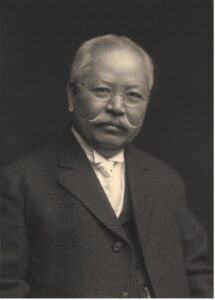
HIGHLIGHTS
Jōkichi Takamine is known for his pioneering research leading to the isolation of adrenaline. Adrenaline has many applications in medicine, including the treatment of anaphylaxis and cardiac arrest.
Jōkichi Takamine was born in 1854 in Takaoka, Toyama, Japan. His father, a physician, encouraged his pursuit of languages and science. Graduating from the Tokyo Imperial University in 1879 with a degree in chemistry, he received a three-year scholarship to pursue post-graduate work at the University of Glasgow and Anderson College. Upon his return to Japan he joined the Ministry of Agriculture and Commerce and worked on improving Japanese agriculture and industry. He went on to receive doctorates in chemical engineering and pharmacology from the University of Tokyo.
In 1887, Dr. Takamine founded Tokyo Artificial Fertilizer Co. (now, Nissan Chemical Corp.), Japan’s first chemical fertilizer manufacturer. Here, he developed a process to brew whisky using kome koji (malted rice). The process yielded a more enzymatically active substitute for barley malt which facilitated faster fermentation and resulted in a more affordable whisky. Later, he discovered that the koji mold enzyme could aid the digestion of starch. He went on to isolate the diastase (an enzyme that catalyzes starch breakdown), which is known as Taka-Diastase and used as a digestive supplement. Dr. Takamine moved to the United States in the 1890s and set up a private laboratory. In 1901 he worked with an associate to develop a method of deriving pure adrenaline in crystalline form, which was a significant achievement in the field of medicine.
Dr. Takamine’s pioneering work was closely linked to intellectual property. For a brief period he served as the temporary Chief of the Japanese Patent Office. For his work isolating Taka-Diastase he was granted the world’s first patent for a microbial enzyme. He was also granted patents for his isolation and crystallization processes related to adrenaline. These were held patentable by Judge Learned Hand in Parke-Davis & Co. v. H. K. Mulford Co., 189 F. 95, a decision considered to be crucial in the development of U.S. patent law.
Dr. Takamine was also a philanthropist, promoting Japanese culture and building friendship between Japan and the U.S. He facilitated the Mayor of Tokyo’s gift of 2000 cherry trees in 1909 to beautify the tidal basin area around the Potomac River in Washington, D.C.
Author: Saukshmya Trichi
